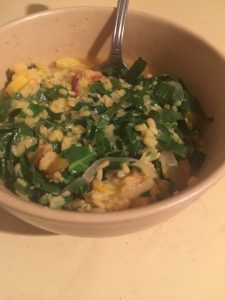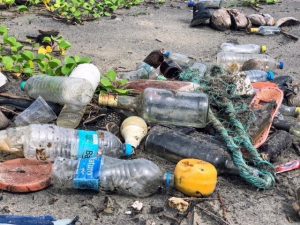
If you’re living in the 21st century, or are health conscious, you most likely have heard of the term “plant-based”eating. This diet is centered around eating a combination of plants, nuts, seeds and grains to gain a completely balanced nutritional palette.
While plant-based eating offers a healthy and more compassionate solution for those who choose not to eat animals, it doesn’t completely address the more interconnected nature of our world, and how the entirety of what we consume affects the environment.
Many vegan and plant-based foods are highly processed, made from non-organic and GMO-containing ingredients, that are often sourced internationally, and packaged in single-use plastic or other non-recyclable packaging. Yes, it is true that these foods don’t contain animal products, but are they inadvertently harming animals and the environment in another way?
Some foods that happen to be plant-based are very damaging to the environment and the use of them helps contribute to the demise of our natural resources and habitats for animals. It is impossible to ignore the images of orangutans and other forest dwellers running for their lives while their homes are burned or bulldozed down for palm oil plantations, a totally unnecessary oil in our diets. Not only is it unhealthy, but its wide use and ever-increasing demand will leave no room for rainforests.
Plastic is Not the Only Culprit
Quite often, people who are trying to eat healthier, or transition to plant-based eating turn to fish. They think it is better and don’t realize the harmful impact that both the farmed and the commercial fishing industry have on the environment. “Fresh” fish and seafood is commonly packed on ice and shipped in styrofoam containers to hundreds of stores, where this styrofoam will then be promptly discarded and sent to the dumpster. That is a lot of styrofoam!
Fish and ocean dwellers often become entangled in the discarded and damaged fishing nets, lines and equipment. This is not a small amount of trash and some estimates put fishing industry waste at about 40% of ocean trash. Most of the time, these innocent bystanders, including seals, dolphins, sharks, sea turtles, birds and whales, cannot avoid the massive nets that are floating in and polluting our oceans. They suffer greatly as they are maimed, injured, and/or drowned. Sadly, these nets will remain in the environment for decades to come and are often called, “ghost nets.”

Micro-Plastics
Plastic is a petroleum-based product that can never decompose because the microbes in the soil haven’t evolved to ingest it. The ways we acquire oil are very detrimental to the environment and animals. Once this plastic enters into the food chain, it may break into smaller and smaller pieces, but in some form will exist forever. These micro-plastics, as well as plastic bags and other types of plastic, are often ingested by animals, or cause the animals to become entangled or trapped in them. Micro-plastics find their ways into our oceans and other once pristine areas of wilderness before finding their way back to us through groundwater, food contamination and other sources. After fish eat the micro-plastics and get consumed by someone else, that person or animal is therefore also ingesting the plastic and the toxic cycle continues, now becoming a part of them – yuck!
Chemical Contamination
Non-organic food is sprayed with toxic pesticides and herbicides that not only harm the soil and pollinators, but also the workers who have to handle it. These workers face exposure to these toxins by directly working with the soil, the plants and the produce. Even if they wear hazmat suits, is this something to which we want to contribute? If the damage to others and the environment isn’t bad enough, these toxins then pass to us through the food itself. Rinsing the food or produce, puts the chemicals into our groundwater and the environment – yuck!
Shipping
Food that needs to be shipped long distances, particularly perishables, require an incredible amount of fossil fuels, resources and energy for transport and refrigeration, which contributes to climate change and threatens a mass extinction of species across the globe. These foods also require excessive packaging to ensure that will stay fresh during their long journey.
Food Waste
Did you know that food waste also contributes to greenhouse gases from the rotting organic matter in the landfills? Some sources say up to 30% of methane and greenhouse gases come from our landfills. It is very difficult, if not impossible for food to break down in landfills because it is entombed in plastic containers, wrapped in cellophane wrap, and probably also in plastic bags! It does not have exposure to the oxygen and aeration that it needs to break down into a soil-enriching, earth-friendly compost. Properly disposing of food waste, composting it and diverting it from landfills helps to reduce this preventable source of additional greenhouse gases.
What is “PLANET-Based” Eating?
 What can we do? We would like to introduce the concept of “PLANET-Based” eating because it aims to address these issues through examining the sources of our food and the packaging.
What can we do? We would like to introduce the concept of “PLANET-Based” eating because it aims to address these issues through examining the sources of our food and the packaging.
Over the last fifty years, we have gradually moved away from valuing our local economies. Supermarkets have come to provide ease of accessibility and convenience at all costs. Summer foods, such as grapes or melons, are now available year-round! It wasn’t that long ago when the only option provided for bagging groceries was brown paper bags. Although re-usuable bags are a better choice, at least brown paper bags could later be used for something else and did not pollute the planet when they biodegraded.
Thankfully, it doesn’t have to be this way! In recent years, farmers markets have expanded, providing many more options for buying organically-produced, local products. Also CSA (Community-Supported Agriculture) farm shares – a portion of the crops in exchange for a few hours of labor, or a per-season fee – have become more trendy and accessible. These are great ways to not only get to know your local farmers, but to get your hands in the soil and connect to the earth. This form of exercise is way more fun than the gym!
Growing your own produce is also an option. If you have a backyard, or even a sunny balcony, starting a small garden is a great way to grow your own produce, such as herbs and greens. Slowing down, spending time in nature, and reaping the direct benefit of the earth’s abundance has the ability to affect our overall well being, as well as our physical health.
Many urban areas are now starting community gardens so more people can have access to gardening space and home-grown food. Maybe you have a friend that needs help with their garden, or has gardening space that isn’t being used? What a great way to spend quality time together!
This also forces us to examine what grows seasonally and how we can adjust our eating to incorporate those seasonal foods, which takes us back to our roots, and helps us to develop a closer connection to the earth. We can preserve extra produce through freezing, dehydrating or canning (for those who are super-ambitious). This reduces the use of single-use packaging that comes with pre-purchased frozen and dehydrated foods. We can preserve and store these things in jars or reusable containers. Life is busy and living closer to the earth takes more time and effort, but these actions have so much to give for our future.
Why Organic?
Choosing organic foods is also very important when considering “PLANET-Based” eating. As we start to understand the importance of a functioning ecosystem, we see how the use of pesticides  that deplete the top soil nutrients, destroy essential micro-organisms and kill insects that help to pollinate, is actually extremely destructive.
that deplete the top soil nutrients, destroy essential micro-organisms and kill insects that help to pollinate, is actually extremely destructive.
Supporting organic agriculture is helping to support farming the land in a way that benefits ecosystems, and replenishes the soil instead of depleting it. It may seem like it is more expensive, but the additional labor that goes into hand-picking weeds and producing healthier plants through healthier soils makes higher quality, organically-produced food more labor-intensive. Organic farming practices cannot compete with chemicals and machines.
It is possible to live in harmony with nature! Organically-grown food not only benefits the planet and others, but also is healthier for us.
What’s In Your Food?
Instead of relying on heavily processed and packaged foods, “PLANET-Based” eating asks us to examine what’s in our food. It urges us to ensure we are eating plenty of whole, plant-based ingredients with minimal processing.
So take all that amazing organic produce from local markets, farm shares, or your own garden, and cook up whole food meals that will nourish you and your family from the inside out. Buy bulk ingredients, whenever possible, and don’t forget to use your own bag or container! Many times, this is more economical. Slow down and enjoy the process of cooking. Make it a family activity in which everyone can participate (and help with clean-up). Sharing food with one another can be an incredible bonding experience. Food can be our most potent form of medicine.
Recently, many farm-to-table restaurants are starting to spring up, so that’s another wonderful option for supporting local food. If your local restaurants don’t offer plant-based food, or better yet, “PLANET-Based” options, request them. There may also be local Meet-Up groups in your area where you can meet like-minded folks that are also trying to learn more about plant-based food, locally-grown food or how to grow more of their own food. Check them out!
Our dollars are essentially a vote for the kind of world we want to build and live in, and through that lens we are able to see how what we support grows.
Ahimsa
One of the goals of “PLANET-Based” eating is to increase our awareness of our interconnectedness with the ecosystems of the planet, and how we can use mindfulness and compassion to make choices that reflect that mindset.
This directly links to the core principle of LWH – Ahimsa, which is compassion and reverence for all living beings and encompassing the intent to create the least amount of harm possible. To read more about it, see our previous post: Behind the LWH Logo and Mission.
At a time in history where the beauty of the natural world is in danger, choosing to live with Ahimsa is more important than ever. We have the power to change the world through intentional and inspired action. Aligning our lives with our moral values not only helps us to come into vibrant health, but will help restore balance to the planet. It all starts with us.
What benefits our health, benefits the health of the whole planet. “PLANET-Based” eating can be used as a tool to help restore and nourish our inner, and outer vibrant health and the health of the planet. It is a concept that may not be an option in all situations, but is something to think about and strive for to help create a kinder world. We can use it as a guide to help make the best choices possible.

Leave a Reply